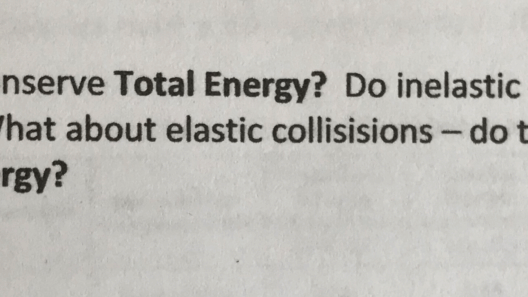The concept of mechanical energy is an integral foundation for understanding the broader principles of physics. It encompasses two fundamental forms: potential energy, inherent in an object’s position, and kinetic energy, arising from motion. Grasping when mechanical energy is conserved not only enriches our comprehension of physics but also unveils the interconnectedness of various natural phenomena. This guide delves into the realms of mechanical energy conservation, providing a delineation of its principles, applications, and scenarios fostering curiosity and insight.
Mechanical energy is conserved under certain conditions, specifically in isolated systems where no net external forces perform work. This conservation law states that the total mechanical energy, a sum of potential and kinetic energies, remains constant if only conservative forces—forces that do not dissipate energy—are at play. Examples of conservative forces include gravitational and elastic forces. In contrast, non-conservative forces, such as friction and air resistance, can dissipate mechanical energy in the form of heat, thus complicating the analysis of energy conservation.
The hallmark of mechanical energy conservation can be observed most vividly in ideal systems, such as a pendulum swinging through an arc. Here, the pendulum converts kinetic energy to potential energy and vice versa. At its highest point, the pendulum possesses maximum potential energy and minimal kinetic energy. Conversely, at the lowest point of its swing, kinetic energy is maximized as potential energy reaches its nadir. Throughout this oscillation, the pendulum’s total mechanical energy remains constant, exemplifying the principle of energy conservation within a closed system.
To further illustrate the nuances of mechanical energy conservation, consider the classic example of a roller coaster. As the coaster ascends, mechanical energy is stored as gravitational potential energy. Upon descent, this energy metamorphoses into kinetic energy, propelling the coaster at dizzying speeds. However, in a real-world scenario, energy losses occur due to friction and air resistance, leading to a gradual decrease in total mechanical energy, thereby negating perfect conservation.
Now, one might ponder: how can we ascertain whether a scenario adheres to the principles of mechanical energy conservation? The following criteria serve as benchmarks:
- In the Absence of Non-Conservative Forces: A primary indicator of mechanical energy conservation is the absence of non-conservative forces influencing the system. Conducting experiments under conditions where friction and external work are negligible can yield valuable insights.
- Closed System Evaluation: An isolated system—untouched by external influences—affords a clear view of energy conservation. Assessing the total mechanical energy at various points within the system can substantiate the conservation hypothesis.
- Consistent Energy Transformations: Observing the interaction between potential and kinetic energies often elucidates whether mechanical energy is conserved. A linear exchange, where energy shifts between forms without loss, typically indicates a conserved system.
- Mathematical Formulation: Utilizing the work-energy theorem can precisely quantify energy transformations. Mathematically, the theorem can be expressed as the work done by the net force equating to the change in kinetic energy. This analytical approach allows for thorough verification of mechanical energy conservation.
Embracing a more inquisitive mindset leads to additional relevant scenarios where mechanical energy conservation manifests uniquely. Take, for instance, the dynamics of an idealized spring. When a spring is compressed or extended, potential energy builds up. Upon release, this potential energy converts entirely into kinetic energy, leading to rapid movement. The spring acts as a conduit for energy transfer without any loss during these idealized situations, showcasing the essence of mechanical energy conservation.
In real-world applications, the implications of understanding mechanical energy conservation extend far beyond academic confines into the realm of technology and engineering. For example, when engineers design systems such as hydroelectric dams, understanding energy conservation principles facilitates efficient energy transfer from potential energy stored in elevated water to kinetic energy driving turbines. This understanding is critical for optimizing resource use and reducing waste, aligning with broader environmental goals.
Moreover, a robust grasp of mechanical energy conservation is pivotal in addressing contemporary challenges. As society moves towards renewable energy technologies, insights derived from mechanical energy principles encourage innovations in energy storage and conversion systems. The exploration of gravitational energy storage systems, for example, represents an exciting frontier where mechanical energy conservation could play a key role in stabilizing energy supply in the face of fluctuating demand.
Curiosity leads us to further inquiries: How might we exploit mechanical energy principles in our quest for sustainability? Can we design urban landscapes that capitalize on gravitational forces, or innovate transportation systems that optimize energy usage? Every exploration of energy conservation beckons new possibilities and perspectives. Through an interdisciplinary approach, merging knowledge from physics, engineering, and environmental science, a profound narrative unfolds—one that advocates for a sustainable future throbbed by the rhythms of mechanical energy conservation.
In summation, discerning when mechanical energy is conserved sets the stage for deeper engagement with the natural world. By emphasizing isolation from non-conservative influences, evaluating closed systems, and observing energy transformation, one can rigorously identify instances of mechanical energy conservation. These insights empower innovations and practices aimed at sustainability, igniting a greater awareness of our ecological imprint. As we strive for a harmonious existence with our environment, the principles of mechanical energy conservation illuminate paths towards resilience and renewal.








